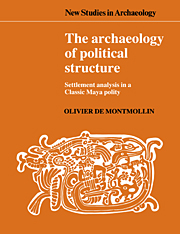Book contents
- Frontmatter
- Contents
- List of figures
- List of tables
- Preface
- 1 Studying ancient complex polities
- 2 Thinking about Maya political structure
- 3 The Rosario polity
- 4 Linking Maya politics and settlement
- 5 Centralization
- 6 Differentiation and integration
- 7 Political regimes and microcosms
- 8 Political stratification patterns
- 9 Mechanical versus organic solidarity
- 10 Segmenting versus non-segmenting organization
- 11 Archaeological study of Maya polities
- Notes
- References
- Index
3 - The Rosario polity
Published online by Cambridge University Press: 29 March 2010
- Frontmatter
- Contents
- List of figures
- List of tables
- Preface
- 1 Studying ancient complex polities
- 2 Thinking about Maya political structure
- 3 The Rosario polity
- 4 Linking Maya politics and settlement
- 5 Centralization
- 6 Differentiation and integration
- 7 Political regimes and microcosms
- 8 Political stratification patterns
- 9 Mechanical versus organic solidarity
- 10 Segmenting versus non-segmenting organization
- 11 Archaeological study of Maya polities
- Notes
- References
- Index
Summary
With a theoretical framework in hand, a range of methodological problems need to be tackled before analytical procedures can be developed and applied towards the goal of characterizing political structure and organization in the Rosario polity. But discussion of methodological problems and application of analytical techniques only make sense with fairly specific reference to the properties of a given archaeological settlement record. To introduce the Rosario settlement record, I now provide a brief sketch of the Rosario polity in its local and wider Maya context.
The Rosario polity occupies a small valley within the Upper Grijalva Tributaries of Chiapas, Mexico (Figures 1 and 2). The Upper Tributaries lie on the southwest edge of the tropical rainforest Usumacinta Lowlands, a core area of Classic Period (AD 300–950) Maya political and cultural development, with major centers such as Yaxchilan, Bonampak, and Piedras Negras (Figure 1). The surveyed part of the Rosario Valley covered just under 53 sq km, estimated to have been almost the entire extent of the Rosario polity's densely settled core. Within this, there was an estimated (maximum) population of 20,000 in the Late/Terminal Classic Period, AD 700–950 (Figures 3 and 4). Adding on (cursorily examined) peripheral area gives a total polity area of 100-150 sq km. Consisting primarily of rugged hills separating the Rosario polity from neighboring polities, most of the peripheral area was very sparsely settled. The Rosario polity core has several nested districts. Two sections correspond to upper and lower valley halves. Seven pockets consist of further divisions of the sections, corresponding to small sub-basins (Figure 5). A political settlement-hierarchy has four discrete levels of centers that include civicceremonial plazas (Figure 5, Table 2).
- Type
- Chapter
- Information
- The Archaeology of Political StructureSettlement Analysis in a Classic Maya Polity, pp. 40 - 49Publisher: Cambridge University PressPrint publication year: 1989



